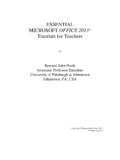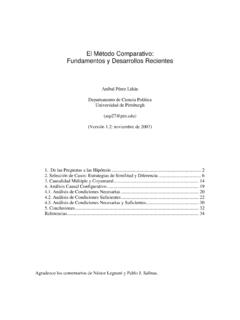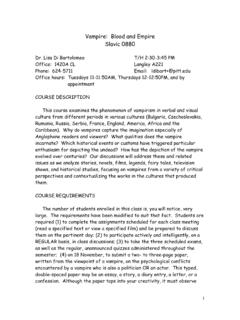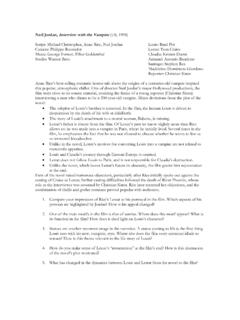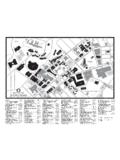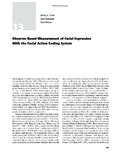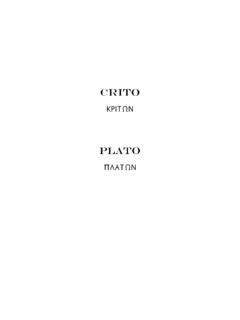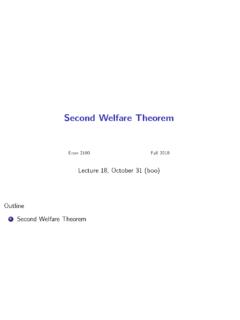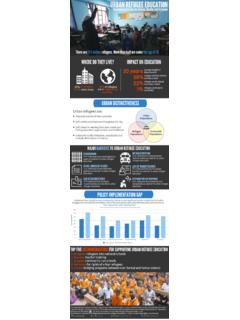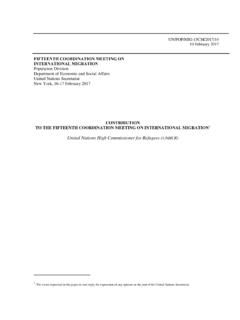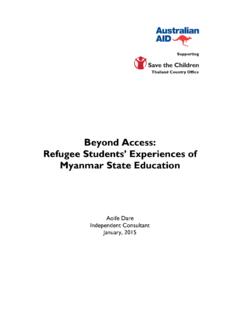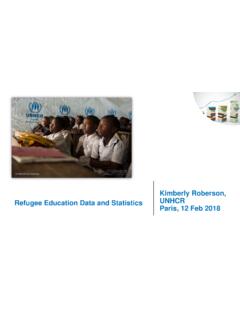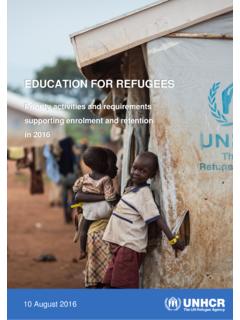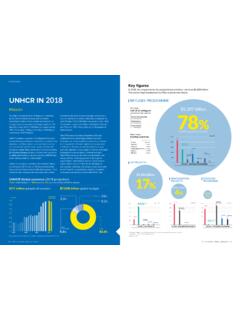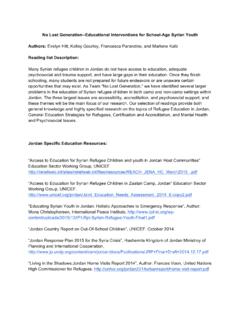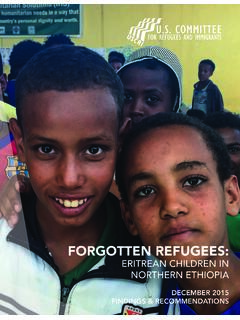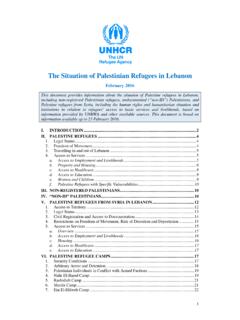Transcription of REVISED (1995) GUIDELINESFOR EDUCATIONAL …
1 UNHCRREVISED (1995)GUIDELINESFOREDUCATIONAL ASSISTANCETO REFUGEESPTSS/June 1995 PREFACEThis REVISED edition of 'Guidelines for EDUCATIONAL Assistance to refugees ' replaces a similardocument issued in May 1992, under IOM 69/92, FOM 68/92. It incorporates policies developedin response to the 1989 Convention on the Rights of the Child, including the 1993 'UNHCRP olicy on Refugee Children', the l994 UNHCR 'Refugee Children: Guidelines on Protection andCare' and recent 'Conclusion. on Refugee Children' of UNHCR's Executive text has been rewritten to take account of the circumstances of the mid-1990s, and inparticular the emphasis on the durable solution of voluntary repatriation. This has majorimplications for refugee education edition of the Guidelines also incorporates information on the Albert Einstein GermanAcademic Refugee Initiative (DAFI), funded by the Federal Republic of Germany to assist refugeestudents attending university-level courses in their countries of asylum.
2 It incorporates GUIDELINESFOR the various types of scholarship under the Annual Programme, which may from 1996 include alimited number of short vocational scholarships for secondary school leavers, to enable them toacquire job-oriented paraprofessional skills in support of a durable solution for themselves andtheir present document is divided into five Parts. Part I of the Guidelines provides anintroduction to the subject of refugee education . Part II gives an overview of UNHCR policies inrespect of different types and aspects of refugee education and readers concerned specifically with education in large-scale refugee situations, Part IIIoffers more detailed guidance on the design and content of education and training IV offers guidelines for staff concerned with the management of scholarship V indicates reporting requirements in respect of education staff are requested to share relevant sections of these Guidelines or a summarythereof with concerned staff of implementing and suggestions to improve the usefulness of these Guidelines are welcomed andshould be addressed to the education Unit.
3 Programme and Technical Support Section (PTSS),UNHCR. The Guidelines will be updated regularly, and readers should confirm that they areusing the most recent Guidelines cover the education sector' (Sector 1) in the UNHCR budget on two activities within this sector (distance education , vocational training) are OF CONTENTSP refaceList of contentsList of AnnexesExecutive Summary(iv)PART I. INTRODUCTION11 . Objectives of refugee education22. Refugee education and international law33. UNHCR support for refugee education and training44. Current situation of refugee education5 PART II. UNHCR education POLICY: AN OVERVIEW65. Assistance policy: schooling86. Assistance policy: secondary school leavers127.
4 Assistance policy: skills training138. Assistance policy: other education sector activities139. Some general policy issues15 PART III. REFUGEE education IN LARGE SCALEEMERGENCIES, ORIENTED TO DURABLESOLUTIONS stages of EDUCATIONAL response in a large scale refugee emergencyPhase 1: 2: Non-formal 3A: education for early voluntary 3B: Adjustment to extended a future for older students (phases I to 3) teacher community-based of girls and and training of disabled of non-traditional environmental, health and reconciliation and cooperation43 PART IV. MANAGEMENT OF SCHOLARSHIP PROGRAMMES 4424.
5 Types of scholarship assistance for secondary school leavers: eligibility for secondary school leavers: newguidelines on courses of of support and , reporting, evaluation and coordination57 PartV. REPORTING III and IV are supplement to Part II. Part III provides more details regardingmanagement of large refugee education programmes, and Part IV offers detailed guidance on themanagement of scholarship from 1989 Convention on the Rights of the DAFI scholarship on scholarships outside the country of of UNESCO's 1994 'Teacher Emergency Package' in schooling by country (Africa Region) of Abbreviations68(iv)EXECUTIVE is recognized under various international legal instruments as a human helps meet the psychosocial needs of displaced and often traumatized refugee children,through restoring structure to their days, providing group activities and encouraging a constructiveattitude to the future.
6 education programmes can convey survival messages and life-skills neededin the refugee situation and contribute knowledge and skills supportive of a durable to 1989 Convention on the Rights of the Child, a 'normative framework of reference' forUNHCR, requires that the ladder of EDUCATIONAL opportunity be 'available and accessible' to everychild; with access to school for all children, and with 'higher education ' being 'on the basis ofcapacity by every appropriate means'. UNHCR can promote such access for refugee children bymeans such as: advocacy; establishment of refugee education coordination committees; and, ifnecessary, contributing resources to supplement the efforts of the refugees , the host governmentand other should ensure that the ladder of EDUCATIONAL opportunity is open to refugee children,in some form, from entry to class I to the level of at least the first secondary school leavingexamination in the system of education which they are a small proportion of students completing secondary school can be given scholarships toattend university or similar courses under the DAFI programme.
7 Other young people completingthis level of schooling should be assisted, where possible, to acquire employment-orientedparaprofessional skills using their secondary education , through individual scholarships or throughinnovative low-cost training programmes. Many will be future leaders and middle-leveladministrators/ technicians in their support for principle that UNHCR should promote access to appropriate education and training forrefugees is universal. The implications of this principle will be different in each specific refugeesituation. The present Guidelines suggest appropriate interventions by UNHCR and otherconcerned agencies in particular scenarios and situations. (Advice may be sought from theEducation Unit, PTSS, regarding education policy and programmes for situations which differsubstantially from those described.)
8 (v) from the international community is most likely to be needed when a large refugeepopulation enters a sparsely inhabited area of a developing country. In this situation, rapideducational response normally requires that the refugee community be assisted to developtemporary schools for their children, which can be gradually improved, pending a durablesolution. Three main phases have been distinguished (by UNICEF/UNESCO/UNHCR):Phase 1: Recreational/ PreparatoryPhase 2: Non-formal schoolingPhase 3: Near-normalcyA:Restoration of curriculumB:Introduction of mixed Phases 1,2 and 3A, the content of schooling should follow the principle of education forvoluntary repatriation, with refugee teachers providing a familiar type of education , using familiarlanguages of instruction.
9 The content of schooling should follow the basic curriculum of thecountry or area of origin. if repatriation is delayed, there should be discussions between refugeeand host government educationists, regarding the possible introduction of a 'mixed' curriculumwhich 'faces both ways', incorporating elements of the host country curriculum, where this issubstantially different (Phase 3B). If return is further delayed, or there is considerable localsettlement, the host country curriculum may be adopted by mutual and youth who were in the upper classes of the school system in their home countryshould be included in the rapid response phase of an emergency; for example, by having classes tomaintain their basic study skills in an afternoon 'shift' at centrally-located 'primary' schools.
10 Olderchildren who were not in school at the time of leaving their home country and who had notcompleted primary education should be admitted to primary school classes if they wish to study,perhaps in a separate 'shift' at centrally-located refugees are mixed among local rural populations, and their children can beaccommodated in local schools, UNHCR or other agencies may assist local schools to absorbrefugee pupils. This solution is more practicable where the language(s) of instruction is/arefamiliar to the refugee UNHCR's role in respect of schooling for urban refugees includes advocacy, coordination,counseling, and support for children from vulnerable Schooling should be provided to refugee children in 'transit' camps (except where the length ofstay is short) and to children who are asylum-seekers.
